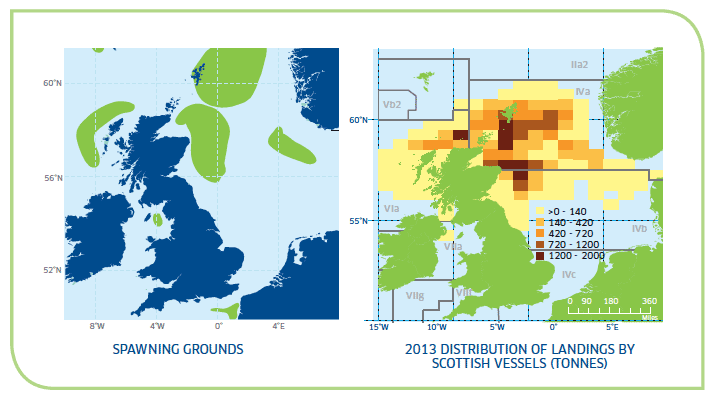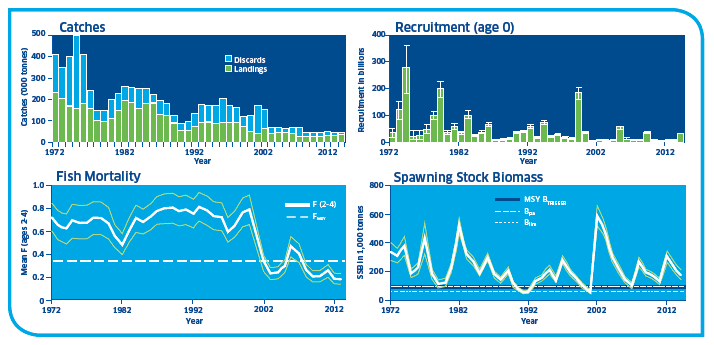Fish and Shellfish Stocks: 2015 Edition
Information on the state of fish and shellfish stocks of commercial importance to the Scottish fleet, inclduing Total Allowable Catches (TACs) for each stock.
Haddock Stocks - North Sea, Skagerrak and West of Scotland (IIIa, IV & VIa)
Haddock ( Melanogrammus aeglefinus) is one of the most important fish for Scottish fishermen. With varying abundance throughout the year, it is caught both inshore and offshore by a variety of gears. The Northern Shelf haddock stock was previously assessed as two separate stocks: Subarea IV and Division IIIaW (North Sea and Skagerrak), and Division VIa (West of Scotland).
2015 position: UK share of 32,108 tonnes
Last Year: 30,925 tonnes
Landed into Scotland in 2013: 36,722 tonnes
Value for 2013: £40.942 million
Biology
In the North Sea, haddock occur mainly in the northern and central areas, but can be found as far south as the Humber Estuary. At the beginning of the 20th century they were also abundant in the southern North Sea.
Virtually all three year old fish are mature and in some years over 80% of two year olds may be mature. A three year old female of average size is able to produce around 300,000 eggs in a season. Haddock release their eggs over several weeks. Spawning runs from February until early May and occurs in almost any area of the North Sea, from the Scottish coast to the Norwegian Deeps. There are differences in the length of the spawning season associated with the size and age of the local population, with age two fish spawning later. The spawning fish on inshore grounds are usually smaller and younger fish than those found in offshore areas. As a result the spawning period of inshore fish can be around half of the time of that found offshore.
In the northern North Sea most of the larvae do not travel far from the spawning grounds. Some larvae from the west coast spawning grounds can be transported to the North Sea, which they enter through the Fair Isle/Shetland Gap or to the north east of Shetland. Young haddock spend the first few months of life in the upper water layers before moving to the seabed.
Tag recapture studies suggest that whilst adult shoals spread out after spawning, many do not inter-mix with haddock from distant spawning areas. Results from early genetic studies on haddock have suggested there could be different populations within the North Sea. However, whilst there are regional differences in maturity between these proposed populations, tagging, parasite and more recent genetic studies have questioned the proposed differences.
The diet of haddock varies with the size of the fish, the time of year, and with the area. In the winter months haddock of all sizes feed mainly on worms, small molluscs, sea urchins and brittle stars. In the spring and summer fish prey are important, particularly for the larger haddock. The type of fish prey reflects the local availability, with Norway pout being the most common fish eaten in the more northerly areas, whereas sandeels are more important in the central North Sea.

ICES Advice on Management
Information Source: ICES advice 2014
http://www.ices.dk/sites/pub/Publication%20Reports/Advice/2014/2014/had-346a.pdf
Quoted text in italics.

MSY and precautionary approach reference points
| Type |
Value |
|
|---|---|---|
| Management Plan (Subarea IV) |
F MP |
0.3 |
| SSB MP |
100,000 t 140,000 t |
|
| MSY Approach (whole area) |
MSY Btrigger |
88,000 t |
| F MSY |
0.35 |
|
| Precautionary Approach (whole area) |
Blim |
63,000t |
| Bpa |
88,000 t |
|
| Flim |
Not defined |
|
| Fpa |
Not defined |
|
State of stock and advice
- Fishing mortality in 2013 is estimated to be 0.183: this means that approximately 16.7%, by number, of all fish between 2 and 4 years of age were caught.
- Spawning Stock Biomass is estimated to be above both Bpa and the M S Y Btrigger in 2014 at around 173, 360 tonnes.
- Fishing mortality and biomass are below and above, respectively, the precautionary limits and the level which is consistent with achieving maximum sustainable yield.
ICES advises on the basis of the MSY approach that catches should be no more than 68 690 t for the whole assessment area. If rates of discards and industrial bycatch do not change from the average of the last three years (2011-2013), this implies human consumption landings of no more than 50 163 t. Measures to reduce discards should be taken in order to protect the incoming recruitment.
A management plan for the whole area needs to be developed, taking into account the need to protect local components of the stock.
A management plan for Subarea IV and Division IIIaW was agreed by EU and Norway in 2008. ICES has evaluated the plan and concludes that it can be accepted as precautionary. An EU management plan proposal for Division VIa was evaluated by ICES and is considered to be precautionary.
Adherence to the EU-Norway management plan in the North Sea and Skagerrak has contributed to lower fishing mortality levels and greatly improved stability of yield.
Discards are highly variable without obvious long-term trend but appear to have been declining in recent years. Discard rates in 2012 and 2013 are the lowest observed in the time-series and appear to be linked to low recruitment. The estimates of discards in the West of Scotland for 2013 are based primarily on sampling by Marine Scotland Science ( MSS; covering around 16 trips), which indicates high discarding in the Scottish TR2 Nephrops fleet (both as a percentage of TR2 catches and as a percentage of total discards).
Management outcomes for 2015
The advice for this stock is given for Subarea IV (North Sea), Division IIIaW (Skagerrak), and Division VIa (West of Scotland), while the TACs for this stock are set for Division IIa ( EU waters) and Subarea IV, the whole of Subarea III, and Division VIa, respectively.
Haddock Northen Shelf TACs
| IIIa | IV | VIa | Total | |
|---|---|---|---|---|
| UK | 28,576 | 3,532 | 32,108 | |
| Union | 2,399 | 33,947 | 4,536 | 408,82 |
In December 2014 at the Council of Ministers meeting in Brussels, the EU Total Allowable Catch for the whole area (IIIa, IV & VI) haddock was set at 40,882 tonnes, with the UK quota for 2015 at 32,108 tonnes.
Contact
There is a problem
Thanks for your feedback